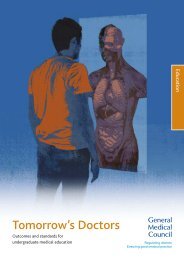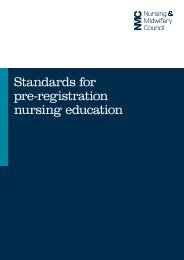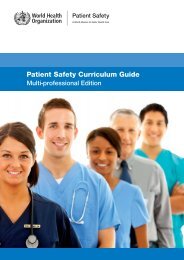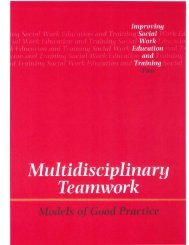Developing Interprofessional Education in health and social care ...
Developing Interprofessional Education in health and social care ...
Developing Interprofessional Education in health and social care ...
Create successful ePaper yourself
Turn your PDF publications into a flip-book with our unique Google optimized e-Paper software.
2. Promot<strong>in</strong>g <strong>Interprofessional</strong> <strong>Education</strong>The progress made <strong>in</strong> promot<strong>in</strong>g <strong>and</strong> develop<strong>in</strong>g IPE would have been impossiblehad it not been for favourable trends <strong>in</strong> higher, vocational <strong>and</strong> professionaleducation, which had been gather<strong>in</strong>g pace over many years. Time, energy <strong>and</strong>money were be<strong>in</strong>g <strong>in</strong>vested to improve teach<strong>in</strong>g <strong>and</strong> learn<strong>in</strong>g. Outcome ledrequirements were free<strong>in</strong>g up curricula. Multidiscipl<strong>in</strong>ary research was pav<strong>in</strong>g theway for multiprofessional teach<strong>in</strong>g <strong>and</strong> learn<strong>in</strong>g. Liberalisation of knowledge wasbe<strong>in</strong>g driven by arguments for open access, open learn<strong>in</strong>g <strong>and</strong> electronic publish<strong>in</strong>g.Broader-based university courses were enlarg<strong>in</strong>g market share as they attractedstudents from a spectrum of discipl<strong>in</strong>es made easier by modularisation, while workbasedlearn<strong>in</strong>g became an <strong>in</strong>creas<strong>in</strong>gly important <strong>and</strong> grow<strong>in</strong>g element <strong>in</strong>undergraduate education. Many <strong>and</strong> varied opportunities resulted to <strong>in</strong>troduce<strong>in</strong>terprofessional learn<strong>in</strong>g.The Labour government put education <strong>and</strong> tra<strong>in</strong><strong>in</strong>g at the heart of its workforcestrategy for <strong>health</strong> <strong>and</strong> <strong>social</strong> <strong>care</strong> (Secretary of State for Health, 1997). Theemphasis at first was on cont<strong>in</strong>u<strong>in</strong>g professional development to reconcile twoobjectives: the legitimate aspirations of <strong>in</strong>dividual <strong>health</strong> professionals; <strong>and</strong> theneeds <strong>and</strong> expectations of services <strong>and</strong> patients. Lifelong learn<strong>in</strong>g would attract,motivate <strong>and</strong> reta<strong>in</strong> high calibre professionals, managers <strong>and</strong> other <strong>health</strong> <strong>care</strong>workers <strong>in</strong> an <strong>in</strong>creas<strong>in</strong>gly competitive labour market. Higher education providers<strong>and</strong> local education consortia (succeeded by Workforce DevelopmentConfederations <strong>and</strong> later <strong>in</strong>corporated <strong>in</strong>to Strategic Health Authorities) would beresponsible for devis<strong>in</strong>g <strong>in</strong>novative approaches to work-based learn<strong>in</strong>g (Departmentof Health, 1998a). The Chief Medical Officer for Engl<strong>and</strong> proposed “practiceprofessional development plann<strong>in</strong>g” (PPDP) <strong>in</strong> primary <strong>care</strong>, tak<strong>in</strong>g <strong>in</strong>to accountuniprofessional <strong>and</strong> multiprofessional learn<strong>in</strong>g needs to encourage team work<strong>in</strong>g,adaptability of professional roles (where appropriate) <strong>and</strong> whole practicedevelopment as a human resource for <strong>health</strong> <strong>care</strong> (Department of Health, 1998b).These proposals went with the gra<strong>in</strong> for IPE activists, re<strong>in</strong>forc<strong>in</strong>g their establishedemphasis on work-based <strong>in</strong>terprofessional cont<strong>in</strong>u<strong>in</strong>g development <strong>and</strong> balanc<strong>in</strong>gthe needs of the worker <strong>and</strong> the organisation.Why the emphasis switched so abruptly to pre-registration <strong>in</strong>terprofessional studiesfrom 2000 onwards is unclear. Post-registration <strong>and</strong> work-based <strong>in</strong>terprofessionallearn<strong>in</strong>g cont<strong>in</strong>ued, but cast <strong>in</strong> the shadows by the government-led drive to promotepre-registration “common learn<strong>in</strong>g”. The NHS Plan stressed the importance ofcollaboration between the NHS, higher education providers <strong>and</strong> regulatory bodies tomake basic tra<strong>in</strong><strong>in</strong>g more flexible, grounded <strong>in</strong> a core curriculum for commonfoundation programmes to promote partnership at all levels <strong>and</strong> to ensure aseamless service of patient centred <strong>care</strong> <strong>in</strong>clud<strong>in</strong>g communications skills <strong>and</strong> NHSpr<strong>in</strong>ciples <strong>and</strong> organisation. Those programmes, it was envisaged, would promote:teamwork; partnership <strong>and</strong> collaboration between professions, betweenorganisations <strong>and</strong> with patients; skill mix <strong>and</strong> flexible work<strong>in</strong>g between professions;opportunities to switch tra<strong>in</strong><strong>in</strong>g pathways to expedite <strong>care</strong>er progression; <strong>and</strong> newtypes of workers (Secretary of State for Health, 2000). The reforms would give frontl<strong>in</strong>estaff the opportunity to th<strong>in</strong>k <strong>and</strong> work differently to solve old problems <strong>in</strong> newways to deliver the improvements set out <strong>in</strong> the Plan (Department of Health 2001b).11













